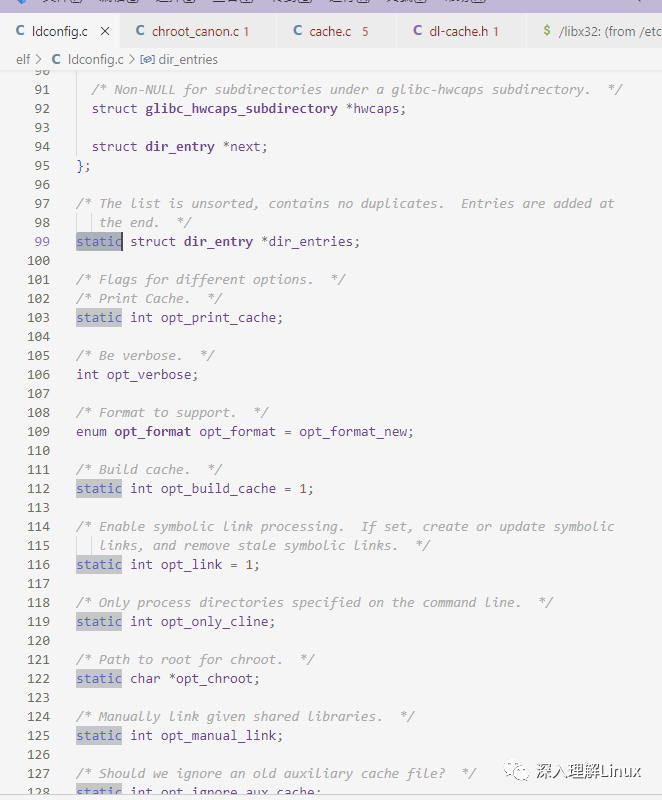
ldconfig的代码中,search_dir()函数的关键内容[1]
这部分关键代码,负责查找指定目录的动态库文件,与系统已有的ld.so.cache的记录对比,如果有变化或系统缓存记录中不存在,则将当前动态库的信息加入到缓存信息链表。
/* Add library to list. 将动态库信息添加到链表*/
struct dlib_entry *dlib_ptr;
for (dlib_ptr = dlibs; dlib_ptr != NULL; dlib_ptr = dlib_ptr->next)
{
/* Is soname already in list? 检查SONAME记录在链表中是否已存在,避免同一个库重复添加多次*/
if (strcmp (dlib_ptr->soname, soname) == 0)
{
/* Prefer a file to a link, otherwise check which one
is newer.
SONAME的判定,以常规文件为优先来源,而不优先以链接文件作为SONAME的来源。
*/
if ((!is_link && dlib_ptr->is_link)
|| (is_link == dlib_ptr->is_link
&& _dl_cache_libcmp (dlib_ptr->name, direntry->d_name) < 0))
{
/* It s newer - add it. */
/* Flag should be the same - sanity check. */
if (dlib_ptr->flag != flag)
{
if (dlib_ptr->flag == FLAG_ELF
&& (flag == FLAG_ELF_LIBC5 || flag == FLAG_ELF_LIBC6))
dlib_ptr->flag = flag;
else if ((dlib_ptr->flag == FLAG_ELF_LIBC5
|| dlib_ptr->flag == FLAG_ELF_LIBC6)
&& flag == FLAG_ELF)
dlib_ptr->flag = flag;
else
error (0, 0, _("libraries %s and %s in directory %s have same soname but different type."),
dlib_ptr->name, direntry->d_name,
entry->path);
}
free (dlib_ptr->name);
dlib_ptr->name = xstrdup (direntry->d_name);
dlib_ptr->is_link = is_link;
dlib_ptr->osversion = osversion;
dlib_ptr->isa_level = isa_level;
}
/* Don t add this library, abort loop. */
/* Also free soname, since it s dynamically allocated. */
free (soname);
break;
}
}
/* Add the library if it s not already in.
如果该动态库没在缓存列表中,则添加到链表记录中。
这里看到,动态库的信息分为name、SONAME、flag、是否为链接、os版本、isa_level这几个方面
*/
if (dlib_ptr == NULL)
{
dlib_ptr = (struct dlib_entry *)xmalloc (sizeof (struct dlib_entry));
dlib_ptr->name = xstrdup (direntry->d_name);
dlib_ptr->soname = soname;
dlib_ptr->flag = flag;
dlib_ptr->is_link = is_link;
dlib_ptr->osversion = osversion;
dlib_ptr->isa_level = isa_level;
/* Add at head of list. */
dlib_ptr->next = dlibs;
dlibs = dlib_ptr;
}
}
继续处理,下面代码仍然是 search_dir()函数的代码,用于核对得到的缓存信息列表的文件,把那些指向软链接的软链接文件,判断为多余的记录(节点),给予剔除。
ldconfig的帮助文档[2]说,/etc/ld.so.cache 文件的内容是有序列表,记录了/etc/ld.so.conf配置文件(及/etc/ld.so.conf.d/*.conf 这些子配置文件)中指定的目录,这些所有目录下的动态库文件的有效信息。除了这些目录,还包含了 通过命令行指定的目录、以及系统必要的目录 /lib、 /lib64 中的动态库文件信息。
/* Now dlibs contains a list of all libs - add those to the cache
and created all symbolic links.
dlibs 包含了指定目录下查找到的所有动态库信息。将用于添加到缓存,并创建软链接(SONAME 文件)。
*/
struct dlib_entry *dlib_ptr;
for (dlib_ptr = dlibs; dlib_ptr != NULL; dlib_ptr = dlib_ptr->next)
{
/* The cached file name is the soname for non-glibc-hwcaps
subdirectories (relying on symbolic links; this helps with
library updates that change the file name), and the actual
file for glibc-hwcaps subdirectories.
/etc/ld.so.cache 文件的
*/
const char *filename;
if (entry->hwcaps == NULL)
{
/* Don t create links to links.
不创建指向链接文件的链接。
*/
if (dlib_ptr->is_link == 0)
create_links (dir_name, entry->path, dlib_ptr->name,
dlib_ptr->soname);
filename = dlib_ptr->soname;
}
else
{
/* Do not create links in glibc-hwcaps subdirectories, but
still log the cache addition.
glibc 的 hwcaps 是2.33 版本开始引入的功能,
支持hwcaps意味着除了常规编译的库之外,现在还可以使用来自最新 CPU
的扩展 cpu 指令集来安装库,glibc 将自动选择针对当前使用的
cpu 优化的版本。ldconfig对于glibc-hwcaps子目录下的动态库,
不会创建对应的SONAME,但仍会记录记录到/etc/ld.so.cache文件内。
以被Linux在运行时按需使用。
*/
if (opt_verbose)
printf ("\t%s -> %s\n", dlib_ptr->soname, dlib_ptr->name);
filename = dlib_ptr->name;
}
if (opt_build_cache)
add_to_cache (entry->path, filename, dlib_ptr->soname,
dlib_ptr->flag, dlib_ptr->osversion,
dlib_ptr->isa_level, hwcap, entry->hwcaps);
}
从上面代码出现的hwcaps相关的处理,在此补充一下关于glibc-hwcaps的作用说明 Hackweek 20: glibc-hwcaps in openSUSE[3];glibc-hwcaps 与AMD CPU的性能优化的关系[4],指出glibc-hwcaps 是基础设施的开始,以便能够更容易地根据硬件功能交付优化的库/共享对象。这是在库级别,用于提供插入式优化库,而不是 GCC 的 FMV(函数多版本控制)之类的库,后者在构建时试图提供优化的函数,然后在运行时根据 CPU 主机进行选择。
以上代码最后看到的 add_to_cache(……),的用法是这样的:
add_to_cache (entry->path, filename, dlib_ptr->soname,
dlib_ptr->flag, dlib_ptr->osversion,
dlib_ptr->isa_level, hwcap, entry->hwcaps);
从名称上看,就是把 找到的一个动态库的记录,添加到缓存数据结构(链表)中。这个是在for (dlib_ptr = dlibs; dlib_ptr != NULL; dlib_ptr = dlib_ptr->next) 的for 每次循环过程的最后执行的,也就是把有效的动态库信息添加到链表。
从上层看,概要的,ldconfig 生成缓存文件,有这样的大体流程:
main() {……
search_dirs (void)//获取所有待查找的目录列表
{
struct dir_entry *entry;
for (entry = dir_entries; entry != NULL; entry = entry->next)
search_dir (entry); // 进入每个目录,查找动态库,并记录到链表中
}
}
if (opt_build_cache)//若命令行参数要求生成缓存文件
{
save_cache (cache_file); //保存最终的缓存结果数据到 指定的缓存文件
//不指定文件路径则默认是/etc/ld.so.cache 文件。
if (aux_cache_file)// aux_cache_file是辅助缓存文件。
save_aux_cache (aux_cache_file);
}
}
看一看这个流程,就对ldconfig如何将最新从/etc/ld.so.conf文件读取的动态库目录下的所有动态库的缓存信息,生成为/etc/ld.so.cache缓存文件,有了整体的认识。
看完这些代码,说几点印象:
- 这些代码考虑到很多方面,不是一次成型的,通过git提交记录,以及changelog文件,我们看到Linux动态库的版本格式从glib4/5/6 有发展演化。
- glibc 的ldconfig的代码是C语言实现的,其生成的/etc/ld.so.cache缓存文件,对于Linux下的依赖动态库的可执行文件的正常运行,关系重大。所以为了优化,和确保软件更新后的稳定性,会有一套命名标准。比如SONAME的命名机制。对软链接是否有效的判断,以及对新动态库的软链接信息的更新。所以总体流程还是比较繁杂的。要考虑到的细节比较多。从git commit历史看,代码维护者的名称大部分是国外开发者。
- ldconfig 的C语言风格有编码排版约定,可读性尚可。也做了模块拆分(如 ldconfig的功能,划分到了多个文件,如入口文件 ldconfig.c 、缓存的读写逻辑实现文件 cache.c 、SONAME文件辅助功能文件readlib.c 、 chroot功能文件 chroot_canon.c )
- ldconfig 的代码存在的不足,也是很多C项目的问题,使用了很多全局变量,各个函数到处在直接操作全局变量。虽然功能上没问题,高手写的代码也不会有运行异常,但总感觉可读性和内聚程度降低了。如果是我来实现ldcnfig,我会在内聚性和代码注释方面做一些改进。减少全局静态变量的使用;改成main()内部的变量,且通过main向被调用的函数传参指针参数的方式传入待读写的变量。以此提高可读性。

- 部分函数的单函数代码行数过长,比如search_dir(),还可以再拆分成多个函数。也是为了可读性能好一些。
- 部分关键结构体的成员变量定义时,没有注释说明其作用。虽然通过看调用代码能知道,但这样的struct定义降低了可读性。
总之,通过本系列文章对Linux 的ldconfig命令的源码,从读动态缓存文件、打印库缓存信息、查找/etc/ld.so.conf 指定的目录的动态库信息等功能做了原理分析。希望对读者理解ldconfig的原理些许帮助。
参考资料:
- [1]ldconfig的代码中,search_dir()函数的关键内容: https://sourceware.org/git?p=glibc.git;a=blob;f=elf/ldconfig.c;h=bccd386761d8cbb226bd3b02c17bf55cd552cee4;hb=HEAD#l702
- [2]ldconfig的帮助文档: https://www.man7.org/linux/man-pages/man8/ldconfig.8.html
- [3]Hackweek 20: glibc-hwcaps in openSUSE: https://antlarr.io/tag/glibc-hwcaps/
- [4]glibc-hwcaps 与AMD CPU的性能优化的关系: https://www.phoronix.com/news/glibc-hwcaps-RFC
原文地址:https://mp.weixin.qq.com/s?__biz=MzA3OTE1MDA2Mw==&mid=2450451320&idx=1&sn=243c72e20c6cd84204b9d4134a7e7629













